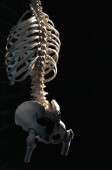No lasting value for minimally invasive lumbar laminotomy

(HealthDay)—For patients with neural foraminal or lateral recess stenosis with unilateral leg neurogenic symptoms (NS), a minimally invasive surgical (MIS) approach offers no advantage over an open lumbar laminotomy approach in the longer term, according to a study published in the Aug. 1 issue of The Spine Journal.
Chia-Liang Ang, M.B.B.S., M.Med., from the Singapore General Hospital, and colleagues compared postoperative improvements in functional and pain scores for open versus MIS lumbar laminotomy in a retrospective study. Data were reviewed for 113 patients who underwent MIS (83 patients) or open (30 patients) unilateral one-level lumbar laminotomy for treatment of neural foraminal or lateral recess stenosis with unilateral leg NS.
The researchers observed no differences in improvement in back or leg pain, or in improvement in Oswestry Disability Index, NS, or Short Form-36 scores at six or 24 months after surgery. At six, but not 24, months there was greater satisfaction with treatment in the MIS group (P = 0.009). Within 24 months, three patients experienced an inadvertent durotomy and two underwent fusion of the operated segment in the MIS group.
"Compared with an open approach, MIS lumbar laminotomy gave no clear advantages in longer-term functional or pain scores," the authors write.
More information:
Abstract
Full Text (subscription or payment may be required)
Copyright © 2015 HealthDay. All rights reserved.





















